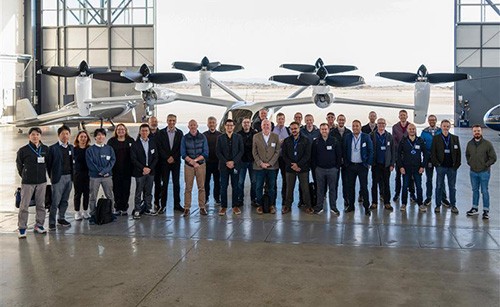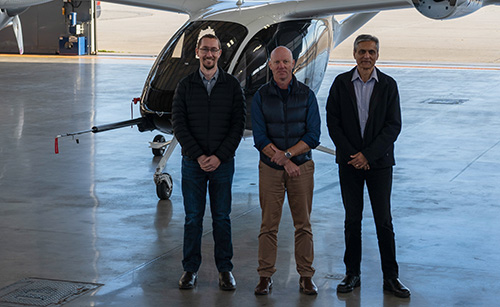CASA staff attend international technical familiarisation meeting in the USA.

Advanced air mobility aircraft are almost here and we're working on a domestic and international level to keep at the forefront of changes sweeping through the global aviation community.
Three CASA senior certification engineers from the Airworthiness and Engineering branch recently spent a week looking at how the US Federal Aviation Administration (FAA) and Joby Aviation are working together to certify the company's electric vertical take-off and landing (eVTOL) Advanced Air Mobility aircraft, the JAS4-1.
Rod Oudshoorn, Philip Khan and Riley Bingham travelled to Joby's facilities in Santa Cruz, California, to participate in the technical familiarisation meeting on the eVTOL AAM.
The CASA trio were joined by their engineering counterparts from national aviation authorities in the UK and Japan in a multi-authority event involving what is likely to be the first AAM to be type certified by the FAA.
Australia's involvement in the meeting is an indication of our international standing as well as the strength of the relationship we enjoy with the US, UK and Japanese aviation authorities.
Rod says the technical familiarisation meeting gave the participants valuable insight into the aircraft's design, certification requirements and how Joby and the FAA were approaching such a certification activity.
'We'd been reading the certification documents for a few months beforehand and it consolidated the understanding of what we'd been reading,' he says.
'We were able to see everything in person and have the opportunity to speak with the manufacturer and designer of the aircraft and the FAA as the certifying authority.'
Joby has formally applied through the FAA for the S4 to be certified by CASA for use in Australia and Rod says the visit will inform our validation of the FAA type certificate.
'This was Joby running us through the details of the design of the aircraft, the progress on certification thus far and also a tour of their manufacturing and testing facilities,' he says.
'There was a lot of information but it was incredibly useful.'
Enlarge image
Also useful was the interaction with the FAA, the UK Civil Aviation Authority and Japan Civil Aviation Bureau about their approach to certification of eVTOL AAM and other novel technologies.
'The in-person meetings just gave us a chance to ask questions in a multi-authority forum,' Rod says.
'Plenty of questions were asked and discussed, and it was useful for us to be present to understand what other authorities are thinking about.
'Questions included details of the design, which assists with the validation, but also the FAA's approach to certification and the engineering to show compliance with airworthiness requirements.'
Rod says the insight gained during the visit will help CASA with the process of gaining valuable insight as we follow our path to certifying AAM aircraft, including its ongoing work with local eVTOL companies such as AMSL Aero.
'This is a first step in gaining that knowledge and we'll be sharing it with the Airworthiness and Engineering branch and beyond our branch to inform operational aspects,' he says.
CASA is also working to enhance global harmonisation by collaborating with other prominent aviation authorities on ways of standardising type certification of AAM aircraft.
-
Aircraft
-
Aircraft registration
- Change, transfer or cancel aircraft registration
- Data files for registered aircraft
- Ferry flight registrations
- Find a registered aircraft
- Guidance for deceased estates
- Irrevocable deregistration and export request authorisation (IDERA)
- Register your aircraft
- Registered aircraft operators
- Registration marks
- Request a copy of your registration certificate
- Airworthiness
- Certification
- Design and manufacturing
- Sport aviation
-
Aircraft registration
- Drones
-
Licences and certificates
- Pilots
- Radio operators
- Air traffic controllers
-
Air operators
- Aerial application air operator's certificate
- Aerial work certificate (Part 138)
- Air transport air operator's certificate
- Alternative pathways for specialised endorsements
- Balloon air operator's certificate
- Flight training operators
- Foreign operators
- Guidance for Part 91 approvals
- Replace air operator's certificate
- Aerial photography from aircraft
- Delegates
-
Maintenance engineers
- About aircraft maintenance engineers
- Aircraft maintenance engineer exams
- Aircraft maintenance engineer licence (Part 66)
- Apply for a Part 66 licence
- Become a licensed aircraft maintenance engineer
- Maintenance of composite structures
- Part 66 and working for a Part 145 organisation
- Part 66 self-study training and examination pathway
- Recognition of prior learning
- Removing exclusions
- Licence currency and requalification
- Modular licensing for aircraft maintenance engineers
- Part 66 modular aircraft maintenance engineer licence pathways
- Flight examiners
- Flight instructors
- Aviation medicals
- Medical professionals
- Aviation reference numbers
- English language standards
-
Operations, safety & travel
- Aerodromes
- Airspace
- Aviation safety for pilots
- Safety Management Systems
-
Safety advice
- Cabin safety
- Carriage or discharge of firearms on aircraft
- Community service flights
- Cost sharing flights
- Dangerous goods and air freight
- Displays and events
- Drug and alcohol management
- Electronic flight bag
- Fatigue management
- Hazard identification and management
- Human factors and safety behaviours
- Mercy fights and operating in an emergency
- 5G and aviation safety
- Safety incident reporting
- Consumer and passenger advice
- Aeronautical information management
- Rotorcraft performance standards for flight operators
- Training and checking systems
-
Rules
- Regulatory framework
- Rules by category
- Rules by status
- Rules by type
- Changing the rules
-
Compliance and enforcement
- Delegated authority in support of aviation safety investigations
- Enforcement action
- How to comply with the rules
- Recent enforcement actions
- Safety information policy statement
- Sharing safety information
- Strict liability
- Surveillance
- Voluntary suspensions
- Recent enforcement actions
- Reporting unsafe behaviour
- Resources & education
-
About us
- Who we are
- Who we work with
- News, media releases and speeches
-
Reporting and accountability
- Environmental management and performance
- Freedom of information
- Gift and benefits register
- Gender pay gap employer statement
- List of CASA files
- Portfolio budget statements
- Register of privacy impact assessments
- Regulator Performance Framework
- Senate order on agency contracts
- Service standards
- Statement of commitment to child safety
- Work health and safety policy statement
- Protecting the environment
- External security vulnerability disclosure program
- Careers
- Sponsorship and scholarship
- About this website
- Contact us
- Events
- Subscribe

